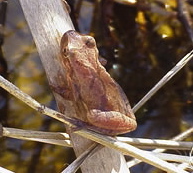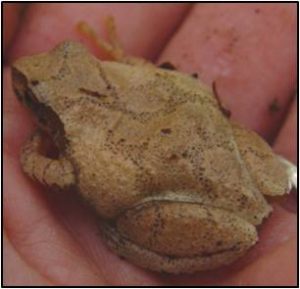Spring Peeper Phenophase Definitions

Image source: J.D. Willson, Savannah River Ecology Lab, http://srel.uga.edu/
Directions: As you report on phenophase status (Y, N, or ?) on the datasheets, refer to the definitions on this page to find out what you should look for, for each phenophase in each species. For reporting animal abundance, if a specific question is included below the phenophase, choose the best answer to the question. If there is no specific question, enter the number of individual animals you observed in each phenophase.
Activity
How many individuals do you see?
Adults on land: One or more adults are seen at rest or active on land.
Adults in water: One or more adults are seen at rest or active in water.

Adults feeding: One or more adults are seen feeding. If possible, record the name of the species or substance being eaten or describe it in the comments field.
Reproduction
Vocalizing: One or more individuals are heard vocalizing.
What is the intensity of vocalizing?
- Single calls: There is space between calls and individuals can be counted.
- Overlapping calls: Calls of individuals can be distinguished but there is some overlapping of calls.
- Full chorus: Calls are constant and overlapping.
Audio for Spring Peeper Calls: To hear examples of Spring peeper calls, you can visit the Missouri Department of Conservation.
Mating: A female is seen grasped and held by a male.
How many individuals do you see?
Fresh eggs: Eggs are seen being extruded, an egg mass is seen with jelly not expanded to full size, or embryos that are more or less spherical are seen.

Image source: S.Smith, ECHO Lake Aquarium and Science Center
How many egg masses do you see?
NOTE: Spring peeper eggs are very small, and are deposited singly on leaf litter and other underwater substrate, not in large clusters like egg masses of other common frog species. It is important to use caution when looking for the eggs, because they are hard to see, and easily trampled.
Development
Dead adults: One or more dead adults are seen, including those found on roads.
How many individuals do you see?
